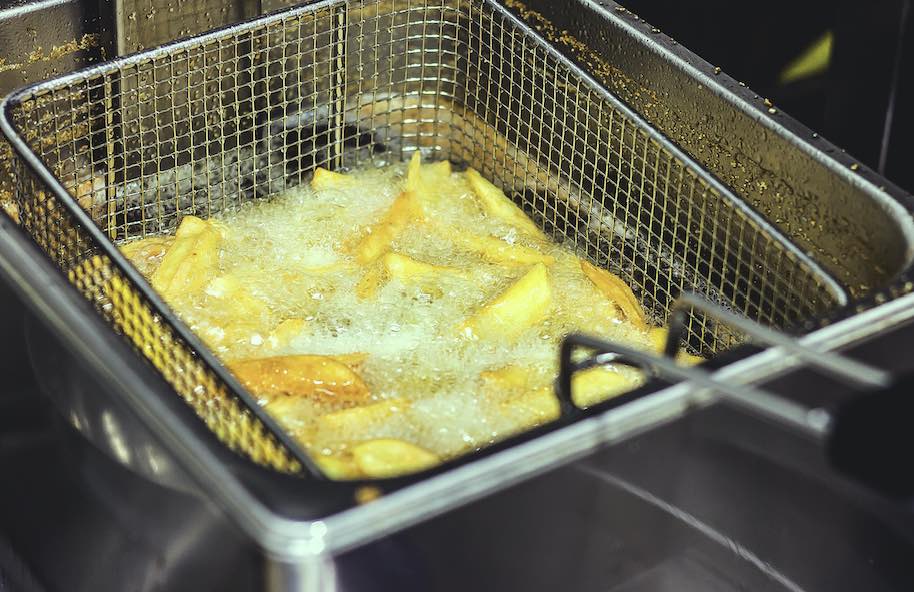Internet Asks: "Can You Deep Fry with Olive Oil?"
Deep frying is a popular cooking method known for its ability to give foods a crispy texture and rich flavor. While various oils are used for deep frying, there's often a question about the suitability of olive oil for this purpose. This article explores whether olive oil can be used for deep frying and the factors to consider for optimal results.
sponsored links

Understanding Olive Oil's Smoke Point
- Smoke Point Considerations: The key factor in determining an oil's suitability for deep frying is its smoke point, the temperature at which it starts to break down and produce smoke. Extra-virgin olive oil has a smoke point ranging from 375-405°F (190-210°C), which can be suitable for some deep frying. However, refined olive oils, with higher smoke points around 465°F (240°C), are better suited for the high temperatures typically required in deep frying.
- Flavor and Health Aspects: Olive oil, particularly extra-virgin, is rich in monounsaturated fats and antioxidants, making it a healthier choice compared to other frying oils. However, its distinct flavor might transfer to the food being fried, which is a consideration based on personal preference.
So, Can You Deep Fry with It?
Given its moderate to high smoke point (depending on the type), olive oil can be used for deep frying, but with caution:
- - Flavor Considerations: Olive oil imparts a distinct flavor that may or may not complement the food being fried.
- - Cost: It's generally more expensive than other oils, which might be a consideration given the large quantities required for deep frying.
- - Health Aspects: Olive oil is rich in monounsaturated fats and antioxidants, which can be beneficial. However, deep frying can lead to the breakdown of some of these beneficial compounds.
Best Practices for Deep Frying with Olive Oil
If you decide to take the plunge and deep fry with olive oil, here are some tips to keep it smooth:
- - Temperature Management: Ensure the oil temperature stays within the smoke point to avoid harmful breakdown products.
- - Quantity: Due to its cost, using olive oil for deep frying might be more suitable for smaller batches.
- - Reusing Olive Oil: Repeatedly reheated olive oil may degrade faster than other oils. It’s advisable to avoid multiple uses for deep frying.
sponsored links
Comparison with Other Oils Suitable for Deep Frying
While olive oil can be used for deep frying under certain conditions, it's important to compare it with other oils commonly used for this purpose:
-
- Canola Oil: With a higher smoke point of about 400°F (204°C), canola oil is a versatile and cost-effective option for deep frying. It has a neutral flavor and is lower in saturated fats compared to olive oil.
-
- Peanut Oil: Popular for deep frying due to its high smoke point of around 450°F (232°C) and its ability to impart a slightly nutty flavor. Peanut oil is more suitable for frying at higher temperatures compared to olive oil.
-
- Sunflower Oil: This oil has a high smoke point (about 440°F or 227°C) and a neutral taste, making it ideal for deep frying without altering the flavor of the food. It's also more economical than olive oil for large volume frying.
-
- Vegetable Shortening: Often used for deep frying due to its high smoke point and ability to produce a very crisp texture. However, it's higher in trans fats compared to olive oil.
-
- Safflower Oil: Similar to sunflower oil, safflower oil has a high smoke point (about 470°F or 232°C) and a neutral flavor. It's a good alternative to olive oil for high-temperature frying.
Conclusion
Deep frying with olive oil is a feasible option, especially when using refined olive oil due to its higher smoke point. While extra-virgin olive oil offers health benefits and a distinct flavor, its lower smoke point makes it less ideal for high-temperature frying compared to alternatives like canola, peanut, or sunflower oils. For those who opt for olive oil, temperature management is key to maintain its beneficial properties. Ultimately, the choice of oil for deep frying will depend on factors like flavor preference, health considerations, and cost.
Disclaimer: This article is for informational purposes only and is not intended as a substitute for professional cooking advice or dietary guidance. Consult with culinary experts or nutritionists for advice tailored to your specific needs.
sponsored links
References
1. Casal S, Malheiro R, Sendas A, Oliveira BP, Pereira JA. Olive oil stability under deep-frying conditions. Food Chem Toxicol. 2010 Oct;48(10):2972-9. doi: 10.1016/j.fct.2010.07.036. Epub 2010 Aug 3. PMID: 20678538.
2. Gorzynik-Debicka M, Przychodzen P, Cappello F, Kuban-Jankowska A, Marino Gammazza A, Knap N, Wozniak M, Gorska-Ponikowska M. Potential Health Benefits of Olive Oil and Plant Polyphenols. Int J Mol Sci. 2018 Feb 28;19(3):686. doi: 10.3390/ijms19030686. PMID: 29495598; PMCID: PMC5877547.
3. University of California, Davis. TEN MYTHS & FACTS ABOUT. https://olivecenter.ucdavis.edu/media/files/myths1933.pdf
4. About Olive Oil. Understanding cooking oil smoke points. https://www.aboutoliveoil.org/understanding-cooking-oil-smoke-points
5. Webstaurant Store. Cooking Oil Smoke Points. https://www.webstaurantstore.com/article/800/cooking-oil-smoke-points.html
People are also reading...
Does Sprite Have Caffeine?
Does Hot Chocolate Have Caffeine?
Does Apple Cider Vinegar Expire?
Apple Cider Vinegar and Cranberry Juice for Weight Loss
See the answer to: "Apple Cider Vinegar and Cranberry Juice for Weight Loss"
️Apple Cider Vinegar and Cranberry Juice Weight Loss
See the answer to: "Apple Cider Vinegar and Cranberry Juice Weight Loss"
Cranberry Juice Apple Cider Vinegar
Does Kahlua Have Caffeine?
Do Cappuccinos Have Caffeine?
caffeine-free-coke-zero?
caffeine-free-dr-pepper?
Calories In a Grilled Cheese?
6 oz Steak Calories?
Ready to level-up?
Create meal plans 10x faster, follow up with your clients through our mobile app, and never struggle with meal planning or recipe management again.